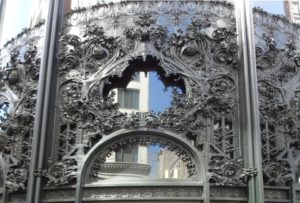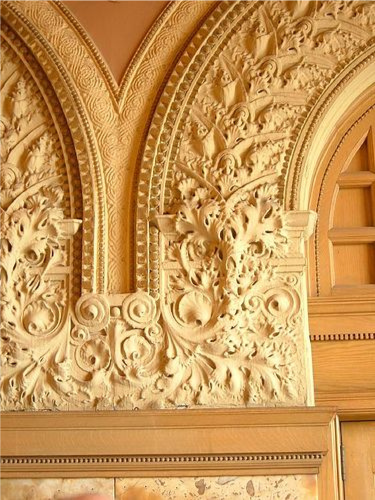 By Maurice Champagne, Class of 2004
By Maurice Champagne, Class of 2004
As we approach refreshers before “opening day” of touring season, some information about Louis Sullivan and the Art Nouveau movement could be of interest. While I’m not advocating for docents to interpret Sullivan’s designs as Art Nouveau, I think it is useful to know what art historians say about him and Art Nouveau.
 It starts in Chicago with the 1893 World Columbian Exposition. While we often focus on how the Beaux Arts buildings in the main court, designed by five New York architects, influenced Chicago architecture, Art Nouveau was also in evidence. Look, for example, at this 1893 poster with its Art Nouveau lettering with curvy tails.
It starts in Chicago with the 1893 World Columbian Exposition. While we often focus on how the Beaux Arts buildings in the main court, designed by five New York architects, influenced Chicago architecture, Art Nouveau was also in evidence. Look, for example, at this 1893 poster with its Art Nouveau lettering with curvy tails.
There is more to the connection between Chicago and the Art Nouveau movement than this poster.
German-born artist Samuel Bing first saw stained glass from the Auditorium Theatre at the 1889 Exposition Universelle in Paris where the Healey and Millet exhibit won the Fair Purchase Prize. In 1892 Bing travelled to the United States, charged with a commission from the French government to report on the industrial arts. He visited the 1893 World’s Columbian Exhibition in Chicago. In 1895, Samuel Bing opened his Salon de l’Art Nouveau, thereby popularizing the term. His gallery displayed “New Art.”
Rolf Achilles, curator of the former Smith Museum of Stained Glass at Navy Pier and teacher at the School of the Art Institute, gave a lecture for Landmarks Illinois in 2014. He argued that Art Nouveau started in Chicago with the Auditorium Building. He repeated that argument in a 2021 interview with architect and Auditorium Theatre Board Member, Matt McNicholas. Here’s a link: https://www.youtube.com/watch?v=MvTq21zN2yE Achilles is the source of the information about Samuel Bing.
Achilles is not alone in associating the Auditorium Building with Art Nouveau. In the Encyclopedia of Chicago, David Garrard Love writes that the “flowing foliate decoration” of the Auditorium Building’s interior spaces are “among the world’s earliest examples of Art Nouveau.” [my bolding]
Sullivan designs are not limited to the Auditorium building. The Art Institute of Chicago’s website describes Sullivan’s Stock Exchange Room as an Art Nouveau design: “This room combines elements of styles ranging from the decorative borders of Celtic manuscripts to the luxuriance of Art Nouveau. [my bolding] Most innovative is Sullivan’s extensive use of stenciling: the elaborate, leaf-like designs use 57 different colors.”
 William Hardy in A Guide to Art Nouveau Style writes, “The decorative metal work over the Carson, Pirie Scott store recalls the florid exuberance of Art Nouveau.” Sullivan “used more overt natural forms of intertwining leaves and branches which became very much a Chicago version of Art Nouveau home-grown but with strong formal links with the style as it had developed within Europe.”
William Hardy in A Guide to Art Nouveau Style writes, “The decorative metal work over the Carson, Pirie Scott store recalls the florid exuberance of Art Nouveau.” Sullivan “used more overt natural forms of intertwining leaves and branches which became very much a Chicago version of Art Nouveau home-grown but with strong formal links with the style as it had developed within Europe.”
Klause-Jurgen Semback in Art Nouveau writes that Sullivan’s “ideas and his work make him part of the Art Nouveau movement.”
Hardy and Semback were writing 80 or 90 years after Sullivan designed these buildings. But a writer contemporaneous with Sullivan associates the architect with Art Nouveau. In the Architectural Record in 1904, H.W. Desmond states in an article titled “Another View – What Mr. Louis Sullivan Stands For”: “Here is ‘Art Nouveau’ indigenous to the United States, nurtured upon American problems…”
Not all art historians agree. Henry-Russell Hitchcock in his article in Art Nouveau states that Sullivan is “parallel to, not an integral part of, the international Art Nouveau movement.”
According to Nikolaus Pevsner in Pioneers of Modern Design, “The two creators [of Art Nouveau] were Louis Sullivan in Chicago and Victor Horta in Brussels. Sullivan was probably essentially original, Horta, no doubt familiar with recent English and Continental developments. Sullivan’s ornament remained solitary. Horta’s created a craze which for a few years swept most countries on the Continent.”
Pevsner notes that Horta influenced Art Nouveau throughout Europe, but that no one in the U.S. followed Sullivan’s designs.
I hope this article gives docents an understanding of how art historians perceive Sullivan’s designs as Art Nouveau. Whether you agree or disagree, it’s important to be aware that some of our tourees knowledgeable about art may know about Sullivan and Art Nouveau.
Sources
Desmond, H. W., “Another View – What Mr. Louis Sullivan Stands For,” Architectural Record, XVI (July 1904)
Hardy, William, A Guide to Art Nouveau Style, Chartwell Books, Inc., Quintet Publishing Limited, 1986
Pevsner, Nikolaus, Pioneers of Modern Design: From William Morris to Walter Gropius, 3rd edition, Museum of Modern Art, 1949
Semback, Klaus-Jurgen, Art Nouveau-Utopia: Reconciling the Irreconcilable, Benedkit Taschen Berlag GMBH, c. 1991
CLICK HERE for more stories on The Bridge.




Thanks Maurice for this article & your recent enlightening CAC zoom presentation. It is great that you have put together the opinions of various art historians, whom we can quote. Sullivan was one of the few US architects of that period who published books and I understood that his writings were particularly admired in European architecture circles (a topic for further research). ——Susan Robertson